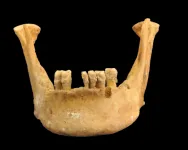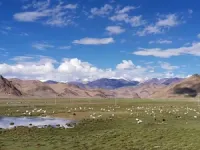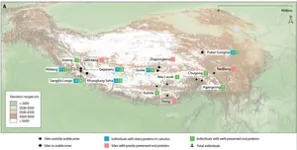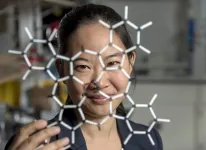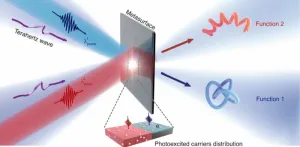(Press-News.org)
The Tibetan Plateau, known as the “third pole”, or “roof of the world”, is one of the most inhospitable environments on Earth. While positive natural selection at several genomic loci enabled early Tibetans to better adapt to high elevations, obtaining sufficient food from the resource-poor highlands would have remained a challenge.
Now, a new study in the journal Science Advances reveals that dairy was a key component of early human diets on the Tibetan Plateau. The study reports ancient proteins from the dental calculus of 40 human individuals from 15 sites across the interior plateau.
“We tried to include all the excavated individuals with sufficient calculus preservation from the study region,” states Li Tang, lead author of the study. “Our protein evidence shows that dairying was introduced onto the hinterland plateau by at least 3500 years ago,” states Prof. Hongliang Lu, corresponding author of this study.
Ancient protein evidence indicates that dairy products were consumed by diverse populations, including females and males, adults and children, as well as individuals from both elite and non-elite burial contexts. Additionally, prehistoric Tibetan highlanders made use of the dairy products of goats, sheep, and possibly cattle and yak. Early pastoralists in western Tibet seem to have had a preference for goat milk.
“The adoption of dairy pastoralism helped to revolutionize people’s ability to occupy much of the plateau, particularly the vast areas too extreme for crop cultivation,” says Prof. Nicole Boivin, senior author of the study.
Tracing dairying in the deep past has long been a challenge for researchers. Traditionally, archaeologists analyzed the remains of animals and the interiors of food containers for evidence of dairying, however the ability of these sources to provide direct evidence of milk consumption is often limited.
“Palaeoproteomics is a new and powerful tool that allowed us to investigate Tibetan diets in unprecedented detail,” says coauthor Dr. Shevan Wilkin. “The analysis of proteins in ancient human dental calculus not only offers direct evidence of dietary intake, but also allows us to identify which species the milk came from.”
“We were excited to observe an incredibly clear pattern,” says Li Tang. “All our milk peptides came from ancient individuals in the western and northern steppes, where growing crops is extremely difficult. However, we did not detect any milk proteins from the southern-central and south-eastern valleys, where more farmable land is available.”
Surprisingly, all the individuals with evidence for milk consumption were recovered from sites higher than 3700 meters above sea level (masl); almost half were above 4000 masl, with the highest at the extreme altitude of 4654 masl.
“It is clear that dairying was crucial in supporting early pastoralist occupation of the highlands,” notes Prof. Shargan Wangdue. Li Tang concludes: “Ruminant animals could convert the energy locked in alpine pastures into nutritional milk and meat, and this fueled the expansion of human populations into some of the world’s most extreme environments.”
END
Researchers from North Carolina State University have developed an electronic patch that can be applied to the leaves of plants to monitor crops for different pathogens – such as viral and fungal infections – and stresses such as drought or salinity. In testing, the researchers found the patch was able to detect a viral infection in tomatoes more than a week before growers would be able to detect any visible symptoms of disease.
“This is important because the earlier growers can identify plant diseases or fungal infections, the ...
Simulated volcanic eruptions may be blowing up our ability to predict near-term climate, according to a new study published in Science Advances.
The research, led by the National Center for Atmospheric Research (NCAR), finds that the way volcanic eruptions are represented in climate models may be masking the models’ ability to accurately predict variations in sea surface temperatures in the tropical Pacific that unfold over multiple years to a decade.
These decadal variations in sea surface ...
In coordination with the El Centro Regional Medical Center (ECRMC) Board of Trustees, UC San Diego Health today announced that Pablo Velez, RN, PhD, has been appointed by UC San Diego Health as ECRMC’s chief executive officer effective April 17. Reporting to UC San Diego Health CEO Patty Maysent, Velez will oversee day-to-day operational, clinical and financial management of ECRMC, leading UC San Diego Health’s overall efforts to support the strategic and operational plan that was announced ...
In a large joint project, a total of six research groups from the University of Cologne Cluster of Excellence on Cellular Stress Responses in Age-Associated Diseases (CECAD), the Max Planck Institute for Biology of Aging (MPI) in Cologne and the University of Göttingen have demonstrated the following findings which apply across the animal kingdom: with increasing age, the transcriptional elongation speed of genes increases, whereby the quality of the gene products suffers. With dietary restrictions, ...
Key Points
Many federal and local government agencies send out a United States Department of Agriculture survey once a year or less to determine whether households experienced food insecurity in the last 12 months.
In a new study, USC researchers found that households are more likely to accurately report food insecurity when surveyed more often and asked about their recent experiences. They also found that the USDA measure may be underreporting the true rate by as much as one-third.
Without ...
ITHACA, N.Y. – Can humans endure long-term living in deep space? The answer is a lukewarm maybe, according to a new theory describing the complexity of maintaining gravity and oxygen, obtaining water, developing agriculture and handling waste far from Earth.
Dubbed the Pancosmorio theory – a word coined to mean “all world limit” – it was described in a paper published in Frontiers in Astronomy and Space Sciences.
“For humans to sustain themselves and all of their technology, infrastructure and society in space, they need a ...
COLUMBUS, Ohio – James P. Allison, PhD, is the recipient of the 25th Herbert and Maxine Block Memorial Lectureship Award for Distinguished Achievement in Cancer. A 2018 Nobel Prize co-recipient in physiology/medicine, Allison serves as the chair of immunology and executive director of the Immunotherapy Platform at The University of Texas MD Anderson Cancer Center.
He is a renowned immunologist whose research led to the discovery of the immune system’s T-cell receptor structure and later a molecule ...
Permanent magnets, the kind found on refrigerators everywhere, exist because their constituent atoms behave as miniature magnets. They align and combine to form the larger magnet in a phenomenon called ferromagnetism. There are some materials where the atomic magnets instead form an alternating pattern, so the material has no net magnetization. Such antiferromagnets have attracted attention for their potential to create faster and more compact magnetic memory devices for computing.
Realizing the full potential of antiferromagnetic devices will require sensing their atom-to-atom magnetic patterns, ...
DETROIT (April 12, 2023) – Henry Ford Hospital structural heart interventional cardiologists Pedro Villablanca, M.D., and Brian O’Neill, M.D., are the first in the U.S. to successfully implant the new transcatheter tricuspid valve replacement device LuX-Valve Plus™ for the treatment of patients with symptomatic tricuspid valve disease for whom traditional open-heart surgery is too high of a risk.
“These are patients with severe tricuspid regurgitation who have no other options available to them in the U.S., based on the anatomy of their native valve and medical complexities,” ...
Dynamic control of terahertz (THz) waves at-will with an ultracompact device is important for THz technologies in biomedical imaging, telecommunications, detection, and beyond. However, tunable THz devices made of conventional materials are usually bulky, and they tend to have limited modulation depths and functionalities, due to weak interactions between naturally existing materials and THz waves. Metasurfaces – functional materials endowed with unparalleled flexibility to manipulate light at the deep-subwavelength scale – provide ...
